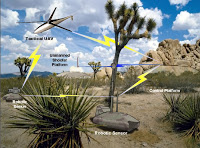 |
| Future Combat Systems |
From nary a cricket, let alone the general public, giving voice to the intrusion of drones in their airspace — the news has now flipped 180-degrees toward being largely dominated by the story of drone surveillance and warfare. New announcements are coming out daily in both mainstream, and in military and aviation journals.
One such announcement comes from Michael Vail’s StratRisks, which sources a recent Aviation Week article that states the following:
Christopher Ames, director of international strategic development at General Atomics, maker of the Predator, says that one way to keep UAVs out of harm’s way when operating in potentially hostile environments is to increase their standoff capability ‘so that you can influence the airspace and the area of interest from a greater distance.’ If the aircraft can operate farther out, ‘then the aircraft themselves don’t need to have the same degree of imbued stealth or survivability,’ he adds, which has the added benefit of decreasing costs since ‘stealth’ doesn’t come cheap. (Source: Aviation Week)
Embedded here is a stated problem that there is growing resistance on the ground to drones flying overhead — many times in undeclared war zones such as Somalia — as well as perhaps a concern over impending military budget cuts. The validity of the latter remains in question, as there is certainly enough in the black budget to access beyond prying eyes. Nevertheless, it is the rest of the Aviation Week report which more than hints toward what our robotic future might hold.
The military has been working for some time on implementing a true terminator-like Skynet Global Digital Defense Network. It is a dystopian science fiction plot that threatens to enter our reality whereby machines have not only supplanted humans on the battlefield, but they have become autonomous — they can work together and make decisions on their own.
This scenario is exactly what is discussed in Aviation Week as they cite the solutions given by drone executives to problems of battlefield exposure and cost:
Despite the challenges, both executives envision a future slightly different than new generations of multicamera sensor balls. Rather, they spoke of operating swarms of networked UAVs that could both provide surveillance coverage over a wider area of interest, while being capable of handing off tasks to one another if any one node was damaged or compromised. Reid says that if something like a Predator or Lockheed Martin RQ-170 Sentinel were flying over contested airspace, ‘that becomes such a tremendous target and such a significant win for the adversary if they can take it out,’ that swarms of smaller UAVs might be better. Having multiple networked assets in the sky creates redundancy, so if one system fails or is destroyed, another can step in and fulfill its mission.
The “swarms” could be both literal — in the form of insect-sized drones like sparrow and dragonfly drones set for the 2015-2030 timeframe — as well as, or in combination with, a computer network swarm approach where autonomous communication between robots and computers form a “net” of redundant data collection, analysis, and military response.
A project called MUSIC, provides insight as to what this future might resemble. It presents a fusion of multiple platforms that is slated to extend across the different branches of the military and can thus potentially play a concert of war between aerial and ground drones of the Army, Air Force, Marines, and Navy:
Not only is MUSIC helping shape the future of CAB units and the Army but its creating connections across joint boundaries to include the Navy, Air Force, and Marine Corps, said Maj. Gen. William T. Crosby, the Program Executive Office, Aviation. (Source)
The capabilities reported in the above press release are echoed in an article from the Washington Post entitled “A Future for Drones: Automated Killing,” which admits that a drone network is being set up which will conduct its mission without the need for human direction:
One afternoon last fall at Fort Benning, Ga., two model-size planes took off, climbed to 800 and 1,000 feet, and began criss-crossing the military base in search of an orange, green and blue tarp.
The automated, unpiloted planes worked on their own, with no human guidance, no hand on any control. (Source)
 An additional capability is being added to keep the drone network aloft indefinitely using lasers to convert power from multiple sources.
An additional capability is being added to keep the drone network aloft indefinitely using lasers to convert power from multiple sources.
Therefore, in the near future, an unblinking, unfeeling, permanent matrix of war will confirm its target independently by data supplied to its sensors, orchestrate the attack plan between its member drones and robots, and execute the mission:
This successful exercise in autonomous robotics could presage the future of the American way of war: a day when drones hunt, identify and kill the enemy based on calculations made by software, not decisions made by humans. (Source)
Here again, we find in Aviation Week the following statement from retired Lt. Gen. David Deptula, who was the Air Force’s first chief for Intelligence, Surveillance, and Reconnaissance, where he indicates the inefficiencies of having a “man-in-the-loop” — in other words, a human. Secondly, he indicates that this use goes beyond war zones, and into “permissive airspace.” Now that we know Congress has officially welcomed drones to America, the following discussion should be particularly concerning:
‘We need to have a balanced capability to operate remotely piloted aircraft both in permissive airspace and contested airspace,’ he says, adding that one of the greatest weaknesses of the fleet is that every platform has to be controlled by an operator on the ground. ‘Those linkages are vulnerable to jamming. To counter that you need to move toward a greater degree of autonomy, but along with moving to autonomy you’ll encounter a variety of policy issues that when you have a man-in-the-loop you don’t have to worry about that much.’
He continues with other logistical issues:
‘What we need to be looking at are innovative ways to accomplish the same kinds of outcomes or desired effects with fewer resources: that being dollars expended, personnel required and numbers of systems,’ he says.
(…)
The key to reducing the amount of data sent to be collected to the ground (which makes it vulnerable to hacking) lies in processing that information on board and sending back only that which is of interest, and adding greater autonomy to the platform so it doesn’t rely on a ‘man-in-the-loop’ to carry out the simplest tasks.
 Given a bottomless budget, political will, and a fear-based populace sweetened with propaganda, the expansion of drone warfare from a useful tool to protect human troops overseas, to a runaway invasive technology that very well could supplant even remote human involvement, is something that needs to be discussed at an urgent pace.
Given a bottomless budget, political will, and a fear-based populace sweetened with propaganda, the expansion of drone warfare from a useful tool to protect human troops overseas, to a runaway invasive technology that very well could supplant even remote human involvement, is something that needs to be discussed at an urgent pace.
If we ignore this exponential development, our own creations threaten to fulfill what only our imaginations have heretofore warned us against.
Final Note: We were unable to find the Defense Department’s fiscal 2011-36 Unmanned Systems Integrated Roadmap that is alluded to in the Aviation Week article. If anyone does find this, please submit in the comments section below. The nearest item seems to be a thesis written for the Naval Postgraduate School that cites the 2007-2032 Roadmap available HERE. This thesis contains a wealth of information about just how comprehensive the development of Unmanned Systems already is, as well as plans for the future expansion. It is available in PDF format HERE. Needless to say at 188 pages and 125 pages, respectively, it is safe to say that the military is all-in on making their vision a reality.
Additional sources:
http://www.wired.com/dangerroom/2012/02/pentagons-black-budget/
https://www.activistpost.com/2011/09/mad-music-of-machine-warfare.html
https://www.activistpost.com/2011/09/6-technologies-for-de-humanizing-war.html
Read other articles from Activist Post here.
Please help us combat censorship: vote for this story on Reddit — http://www.reddit.com/r/conspiracy/comments/pv5pl/autonomous_drone_swarms_set_to_launch_reducing/


Be the first to comment on "Autonomous Drone Swarms Set to Launch, “Reducing Burden” on Humans"